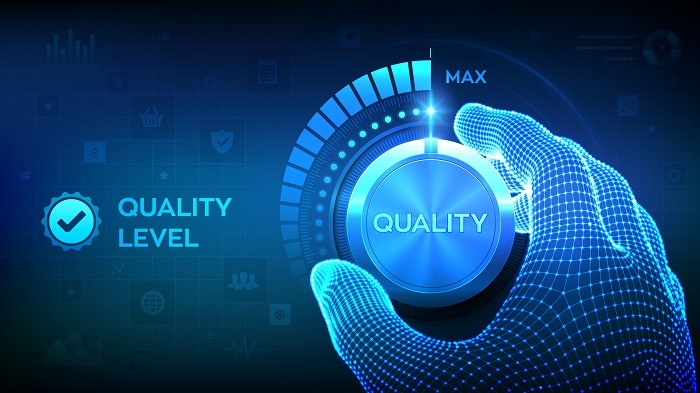
 Data Structure
Data Structure Networking
Networking RDBMS
RDBMS Operating System
Operating System Java
Java MS Excel
MS Excel iOS
iOS HTML
HTML CSS
CSS Android
Android Python
Python C Programming
C Programming C++
C++ C#
C# MongoDB
MongoDB MySQL
MySQL Javascript
Javascript PHP
PHP
- Selected Reading
- UPSC IAS Exams Notes
- Developer's Best Practices
- Questions and Answers
- Effective Resume Writing
- HR Interview Questions
- Computer Glossary
- Who is Who
How Can Project Managers Ensure Effective Project Quality Control?
Quality control is an integral part of project management and plays a significant role in determining a project's ultimate success. The goal of quality assurance is to guarantee that the delivered product lives up to all of the requirements set forth by the project's stakeholders.

Assigning roles and responsibilities, conducting quality audits and reviews, implementing corrective actions and continuous improvement, facilitating effective communication and collaboration among team members, and incorporating quality control into the project schedule and budget are just some of the tools available to project managers for achieving successful quality control. An in-depth discussion of these techniques is provided here, along with an emphasis on quality assurance's central role in project management.
Understanding the Importance of Quality Control in Project Management
Several methods, including the establishment of quality standards, the creation of a quality management plan, and the implementation of routine quality checks, are available to project managers for achieving successful quality control.
A formal quality management system can cut down on project costs by as much as 20%, according to one study. This exemplifies the significance of quality assurance in project management and its bearing on the final outcome.
Therefore, project managers should make quality control a top priority to guarantee that their project lives up to, if not exceeds, stakeholder expectations.
Defining Quality Objectives and Criteria for the Project
Defining Project Quality Objectives and Criteria is an important aspect of effective project quality control. Quality objectives are the specific quality goals that a project team wishes to achieve, whereas quality criteria are the specific standards used to determine whether those goals have been met.
For example, if the goal of a software development project is to reduce the number of bugs in the final product, the quality criteria may include a maximum allowable number of bugs per thousand lines of code. These criteria can be used to assess the final product's quality and determine whether it meets the established quality objectives.
According to a Project Management Institute study, projects with well-defined quality objectives and criteria are more likely to be completed on time, within budget, and to stakeholders' satisfaction. In fact, projects with clearly defined quality objectives and criteria have an 89% success rate, compared to 33% for projects with poorly defined quality objectives and criteria.
Developing a Quality Management Plan

Creating a quality management plan is crucial for maintaining a high standard of quality throughout a project. Research conducted by the Project Management Institute (PMI) found that compared to organizations without a formalized approach to quality management, those with one achieved 64% of project goals on average. Therefore, it is essential for project managers to develop a comprehensive quality management plan that details the quality goals, procedures, and roles of all team members. Possible quality risks and solutions to those risks should be outlined in this plan. The success of a project and the quality of its outcomes can be enhanced by the use of a well-developed quality management plan.
Assigning Roles and Responsibilities for Quality Control
Effective quality control in a project depends on clearly delineated roles and responsibilities. It is the manager's responsibility to make sure that everyone on the team knows what they're supposed to be doing to maintain quality standards. It's important to lay out the roles that each team member will play and equip them with the tools they'll need to succeed.
For instance, one team member may be tasked by the project manager with conducting routine quality checks on the project's deliverables, while another may be tasked with documenting and communicating the team's quality control procedures. The project manager may also delegate this responsibility to a member of the team who will review the plan on a regular basis to ensure it continues to meet the project's objectives and quality benchmarks.
The project manager's ability to ensure that all team members are held accountable for the project's quality and that a system is in place to monitor and address any issues that arise is greatly enhanced by the assignment of clear roles and responsibilities for quality control. This can increase the likelihood that the project will be completed on time, under budget, and to everyone's satisfaction.
Conducting Quality Audits and Reviews
Conducting quality audits and reviews is a crucial part of ensuring efficient project quality control. To ensure the project is completed to the required standards and specifications, the work that has been completed must be thoroughly inspected and evaluated.
A quality audit is a review of a project's documentation, processes, and deliverables by the project manager to find problems and areas for improvement. This ensures the project stays on track and that the end result is satisfactory to all parties involved.
However, in a quality review, participants share their thoughts on the project's development and overall satisfaction. This information can be used to make course corrections and enhancements, keeping the project on track to complete successfully.
Implementing Corrective Actions and Continuous Improvement
Project managers must take corrective actions and enhance the project processes in order to guarantee that the project will be completed to the required quality standards. When problems are found that need fixing, corrective measures are implemented. Plan adjustments, task reassignments, and new procedure launch all fall under this category.
Analysis of the project's processes should lead to the discovery of opportunities for improvement. To achieve this goal, it is possible to gather comments, monitor metrics, and adjust accordingly. Corrective actions and ongoing improvement allow project managers to guarantee that their work is up to par and producing the expected results.
Ensuring Effective Communication and Collaboration among Team Members
Managers of projects can improve communication by fostering an environment of open dialogue among team members and providing a mechanism for routine status updates and discussions. Furthermore, they need to outline the duties of each team member to ensure that everyone is doing their part to ensure the project's success.
The ability to work together as a team is also essential. Managers of such projects can encourage teamwork by fostering an environment that prizes collaboration and mutual aid. They need to inspire the team to collaborate effectively, share ideas, and back each other up as they work.
Integrating Quality Control into the Project Schedule and Budget
Integrating quality assurance activities into the project plan and budget helps project managers keep things on track. In order to ensure a successful project outcome, quality control activities must be incorporated into the plan and given sufficient time and resources. As a result, the project team can address any quality concerns early on and hopefully avoid more serious issues down the road. This method is useful in guaranteeing that the final product satisfies the stakeholders' expectations for quality. The project manager must also keep a close eye on the quality control procedure to ensure its efficacy and make any necessary adjustments to it.

